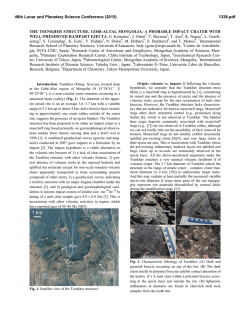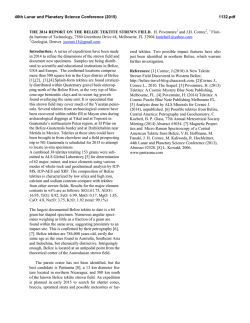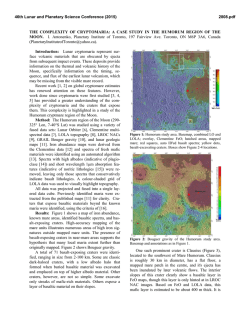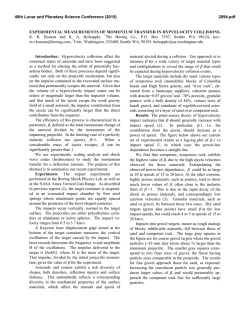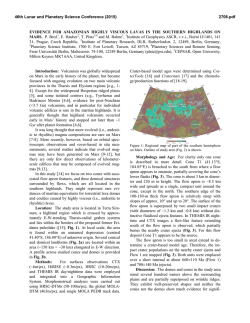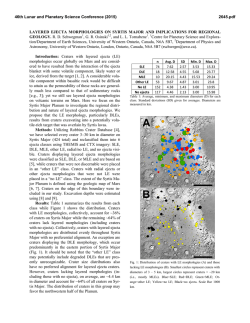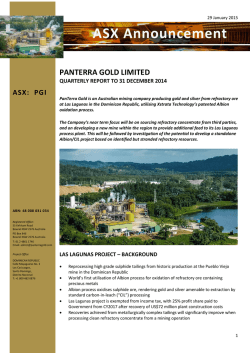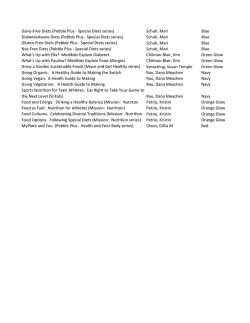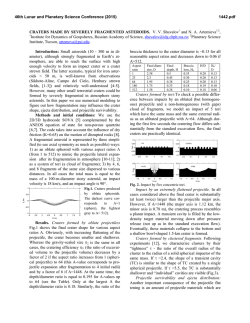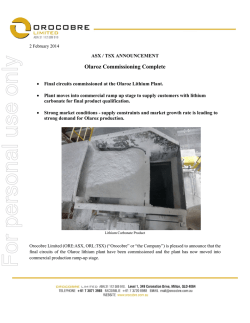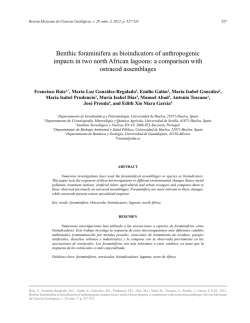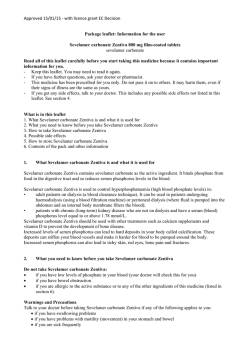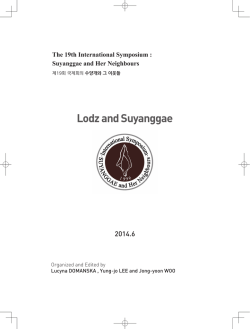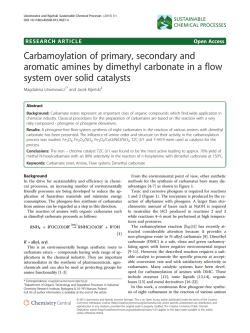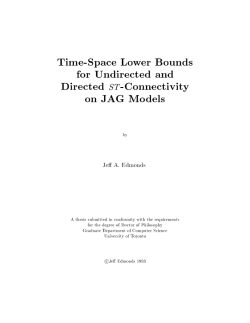
documento 470439
46th Lunar and Planetary Science Conference (2015)
1408.pdf
CORRELATION OF NORTHERN BELIZE’S CRETACEOUS-PALEOGENE ("KT") BOUNDARY
SECTIONS. D. T. King, Jr.1 and L. W. Petruny1, 1Geology Office, Auburn University, Auburn, Alabama 368495305 USA; [email protected].
Introduction: During the Chicxulub impact (or
"KT" boundary) event of 65 m. y. ago, direct ejecta
covered part of the Yucatán peninsula, including Belize
[1-3]. In northern Belize, these ejecta consisted of vapor plume deposits with accretionary lapilli, glass
fragments, and debris-flow deposits that accumulated
as the ejecta curtain collapsed. These ejecta deposits
occur today within fault-bounded graben fills and crop
out at several places in northern Belize (Figs. 1 and 2).
Albion Island: At Albion Quarry (on Albion Island), Belize (~ 400 km from impact), about 15 m of
direct ejecta crops out at a local quarry [1-4]. The stratigraphy of this deposit, from base upward, is ~1 meter
of clay (resting on the eroded surface of the
Maastrichtian (Barton Creek) dolostone) that has a
minor component of carbonate spherules (formerly
accretionary lapilli?), which is followed upward by ~14
m or more of impactoclastic carbonate breccia (carbonate clasts with a wide range of sizes within a fine
clay, pulverized carbonate, and glass-fragment matrix;
Fig. 3). The glass (vesicular, irregular fragments) in the
matrix is now largely altered to green clay.
Progresso Lagoon: A similar pebble deposit, over
5 m thick, occurs at a site that is east of Albion Quarry
and north of Armenia [5]. This site, called Progresso
Lagoon, is an important location for preservation of the
ballistically emplaced pebbles because their preservation at this site is much better than others in the area
(especially regarding their surface textures, which included polish, pits, and striations; Fig. 4).
Armenia: At Armenia, Belize (~450 km from impact), ~10 m of direct ejecta and related KT boundary
deposits crop out on a main highway [3]. These deposits include a boulder-bearing paleosol (atop the local
Maastrichtian dolostone), a vapor plume deposit with
accretionary lapilli and irregular, vesicular glass fragments, and a polished pebble bed [3]. It is likely that
the vapor plume deposit at Armenia is the lateral
equivalent of the impact breccia layer at Albion Quarry. The polished pebble bed is likely a secondary (reworked) deposit of ballistically emplaced pebbles that
washed from the land surface into the low-lying area of
the small graben basin at Armenia [5].
Correlation of sections: The datum for correlation
is the top of the Maastrichtian dolostone section (top of
the Barton Creek formation; Fig. 2). The brown clay
bed at Albion Island contains small dolomitic lapilli,
but the brown clay bed at Progresso Lagoon does not
have these lapilli. These clay beds are provisionally
correlated because there is a similar impactoclastic
breccia layer above this basal clay bed at both Albion
Island and Progresso Lagoon. Above the
impactoclastic carbonate breccia at both Progresso
Lagoon and Armenia is deposit of impactoclastic pebble conglomerate. At Armenia, the impactoclastic carbonate breccia is missing between the lapilli-bearing
basal layer and the impactoclastic pebble conglomerate. These physical relationships represent facies
changes within the distal part of the ejecta deposits that
formed near sea level on the western side of the Yucatán peninsula, north of the Maya Mountains.
References: [1] Ocampo A. C. et al. (1996) GSA
SP 307, 75-88. [2] Pope K. O. et al. (1999) EPSL 170,
351-364. [3] Pope K. O. et al. (2005) GSA SP 384,
171-190. [4] King Jr. D. T. and Petruny L. W. (2003)
Springer impact series. [5] King Jr. D. T. and Petruny
L. W. (2014) GSA annual mtg. abst. 241668. [6] King
Jr. D. T. and Petruny L. W. (2012) GCAGS Trans. 62,
227-242.
Acknowledgements: Auburn U. VPR IGP 2014.
Figure 1. Location of KT boundary sections in northern Belize. AI = Albion Island; PL = Progresso Lagoon; Ar = Armenia. Blue dashed lines are faults [6].
PL
AI
Ar
46th Lunar and Planetary Science Conference (2015)
Figure 2. Correlation of KT boundary sections, northern Belize. Numbered points: (1) impactoclastic breccia at surface; and, a few km away, Paleogene limestone beds occur above this unit; (2) a horst occurs
between these sections (see faults in Fig. 1); correlation
line between these sections suggests that the brown
clay may be the same or a similar layer; (3) the
impactoclastic pebble conglomerate is interpreted as
fluvial re-deposition of Chicxulub primary ejecta,
which rests on an erosional surface above the direct
ejecta; these pebble deposits are restricted to the
graben areas where Chicxulub direct ejecta are preserved as well; (5) a horst occurs between these section; same notes as (2); (6) these deposits likely abut
against this fault or are otherwise confined to this
graben; (7) the impactoclastic carbonate breccia may
have occurred at this level, and was eroded away subsequently, or this layer may be the equivalent of the
impactoclastic carbonate breccia – but with lapilli (carbonate spherule) components; (8) this is a glassfragment-bearing deposit that contains also lapilli and
carbonate clasts up to 10 cm in diameter; this deposit is
in the same stratigraphic position as the brown clay bed
at Albion Island and Progresso Lagoon, but is compositionally significantly different.
1408.pdf
Figure 3. Overview of uppermost Maastrictian and KT
boundary interval, Albion Island, Corozal District,
Belize.
Figure 4. Overview of section PL-1 in Progresso Lagoon composite section, Corozal District, Belize.
© Copyright 2025
